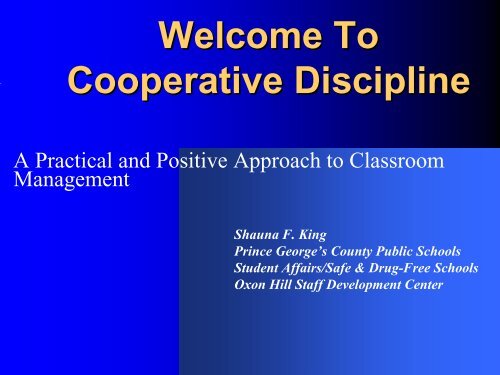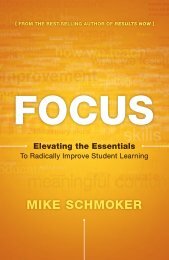cooperative+discipline
cooperative+discipline
cooperative+discipline
You also want an ePaper? Increase the reach of your titles
YUMPU automatically turns print PDFs into web optimized ePapers that Google loves.
Welcome To<br />
Cooperative Discipline<br />
A Practical and Positive Approach to Classroom<br />
Management<br />
Shauna F. King<br />
Prince George’s County Public Schools<br />
Student Affairs/Safe & Drug-Free Schools<br />
Oxon Hill Staff Development Center
The Cooperative Discipline<br />
Approach<br />
Goal: To develop safe and caring<br />
classrooms and create solutions to<br />
classroom disruptions and school violence.<br />
Learning Objective: To identify and teach<br />
strategies teachers can use to influence<br />
students to choose responsible behavior.
The Cooperative Discipline<br />
Approach<br />
Three Theories:<br />
1. Students need to belong.<br />
(Encouragement Strategies-Capable, Connect, Contribute)<br />
2. Students misbehave for a purpose.<br />
(Intervention Strategies- 4 Goals of Misbehavior)<br />
3. Students need to have a voice in decisions that<br />
affect them.<br />
(Collaboration Strategies- Hands Joined Decision Making)
Cooperative Discipline Answers<br />
Three Questions<br />
• What do I do when kids act up?<br />
(Corrective)<br />
• What can I do so they won’t continuing<br />
misbehaving? (Supportive)<br />
• How can I encourage the “good kids” to<br />
continue behaving appropriately<br />
(Preventive)
Supporting Staff and Student<br />
Behavior
Analysis Alley<br />
• Parents Recently<br />
Separated<br />
• Ethnic Background<br />
• IQ Level<br />
• No Breakfast<br />
• Hard Drive Died on<br />
Computer<br />
• Ditched By Best<br />
Friend<br />
• Parent Unemployed<br />
• Alcoholism in the<br />
Family<br />
• Dog Ran Away<br />
• Did not make the<br />
Basketball Team
The Four Goals of Misbehavior<br />
• Attention “Look at Me”<br />
• Power “Let’s Fight/You Can’t Make Me”<br />
• Revenge “I’ll Get Even”<br />
• Avoidance of Failure “Leave Me Alone”
Identifying the Goal<br />
• How do I feel?<br />
• What do I usually do?<br />
• As a result, what does the student do?
Attention Seeking Behavior<br />
• I feel irritated and<br />
annoyed<br />
• My impulse to<br />
respond is to nag,<br />
remind, correct or<br />
rescue.<br />
• When I do respond,<br />
the misbehavior<br />
stops, at least<br />
temporarily.
Interventions for Attention<br />
• Give the Eye<br />
• Target-Stop-Do<br />
• Grandma’s Law<br />
• Stand Close By<br />
• Name Dropping<br />
• Proximity<br />
Praise/Compliance<br />
Praise<br />
• Talk To The Wall<br />
Seeking Behavior
Preventing Attention Seeking<br />
Behavior<br />
• Give lots of Positive Attention for<br />
Appropriate Behavior<br />
• Teach students how to ask for<br />
attention<br />
• Allow for “student spotlight”
Power Seeking Behavior<br />
• I feel angry or<br />
frustrated.<br />
• My impulse to<br />
respond is to fight<br />
back or give in.<br />
• When I do respond,<br />
the misbehavior<br />
continues until it<br />
stops on the student’s<br />
own terms.
Revenge Seeking Behavior<br />
• My pressure gauge is<br />
boiling. I feel hurt,<br />
anger or dislike.<br />
• My impulse to strike<br />
back or withdraw<br />
emotionally.<br />
• When I do respond,<br />
the misbehavior<br />
intensifies until it<br />
stops on the student’s<br />
own terms.
Interventions for Power and<br />
Revenge Behavior<br />
Revenge Behavior<br />
Graceful Exits-Fogging<br />
Techniques<br />
• Acknowledge Student<br />
Power<br />
• Agree With the student<br />
• Deliver a Closing<br />
Statement<br />
• State Both Viewpoints<br />
• Call the Student’s Bluff<br />
• Table The Matter
Preventing Power and Revenge<br />
Behavior<br />
• Grant legitimate power<br />
• Avoid and defuse confrontations<br />
• Control Self<br />
• Build Caring Relationships<br />
• Teach strategies to deal with<br />
aggressive feelings and hostility
Avoidance of Failure Behavior<br />
• I feel frustrated or<br />
professional concern.<br />
• My impulse to<br />
respond is to give up<br />
or seek help.<br />
• When I do respond,<br />
there is no change in<br />
behavior and work<br />
continues to be<br />
avoided.
Interventions for Avoidance of<br />
Failure Behavior<br />
Failure Behavior<br />
• Make Mistakes Okay<br />
• Model learning from<br />
mistakes<br />
• Break tasks in to<br />
component parts<br />
• Teach positive selftalk
Preventing Avoidance of<br />
Failure Behavior<br />
• Erase the rule of the red pen.<br />
• Decrease competition<br />
• Keep expectations reasonable.<br />
• Use Encouragement<br />
Strategies(Capable, Connected,<br />
Contributing)
Intervention and Prevention<br />
Strategies<br />
Attention<br />
Power<br />
Revenge<br />
Avoidance<br />
of Failure<br />
Target-Stop<br />
Do<br />
Acknowledge<br />
their power<br />
Graceful<br />
Exits<br />
Decrease<br />
competition<br />
Give the<br />
eye<br />
Acknowledge<br />
appropriate<br />
behavior<br />
Table the<br />
matter<br />
Grant<br />
legitimate<br />
power<br />
Consequences<br />
Chart<br />
Build caring<br />
relationships<br />
Modify<br />
instructional<br />
methods<br />
Make<br />
Mistakes<br />
Okay
Guidelines for Intervention<br />
• Focus on the behavior, not the<br />
student.<br />
• Take charge of negative emotions<br />
• Avoid escalating the situation.<br />
• Discuss misbehavior later.<br />
• Allow students to save face.
Influencing Student Choices<br />
• Positive teacher<br />
behavioral<br />
expectations<br />
• Hands-joined style of<br />
classroom<br />
management.<br />
• Individualized<br />
responses to<br />
misbehavior<br />
• Encouragement for<br />
all<br />
• Clear behavior<br />
standards<br />
• Collaborative<br />
conflict resolution.<br />
• Involvement of<br />
students in discipline<br />
process.<br />
• Involvement of<br />
parents as partners.
More Information on<br />
Cooperative Discipline<br />
American Guidance Services<br />
www.cooperativediscipline.com<br />
Teacher Handbooks<br />
Administrative Guides<br />
Training Manuals and Videos<br />
National Facilitators<br />
Shauna F. King<br />
Shauna.King@pgcps.org<br />
301-749-4379<br />
301-749-5220(fax)





